The weather was spectacular this last weekend that I decided to take a trip to the region around Haute Normandie known as the Seine Maritime. After making several stops to get pictures of the fields covered in rape flowers, or colza as it is known in France, I made my first stop in the delightful city near the Channel known as Fécamp. 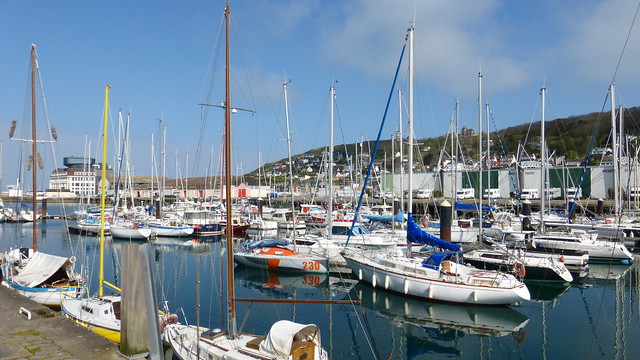 It is a fishing port as well as a center for pleasure boats. According to its late medieval founding legend, the trunk of a fig tree (ficus) carrying the Precious Blood of Christ collected by Joseph of Arimathea was washed ashore on the riverbank at Fécamp in the 1st century. Immediately, a fountain of holy blood gushed from the site; the relic attracted many medieval pilgrims, enhancing the reputation of the city.
It is a fishing port as well as a center for pleasure boats. According to its late medieval founding legend, the trunk of a fig tree (ficus) carrying the Precious Blood of Christ collected by Joseph of Arimathea was washed ashore on the riverbank at Fécamp in the 1st century. Immediately, a fountain of holy blood gushed from the site; the relic attracted many medieval pilgrims, enhancing the reputation of the city. 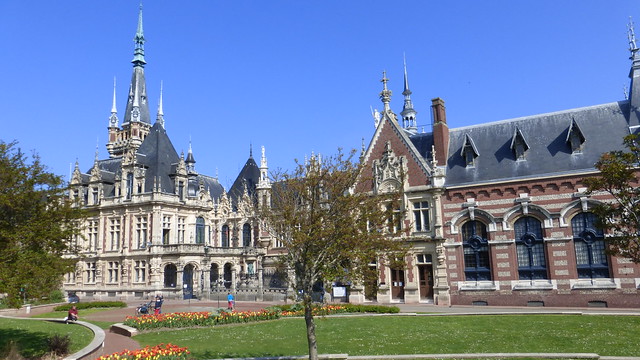
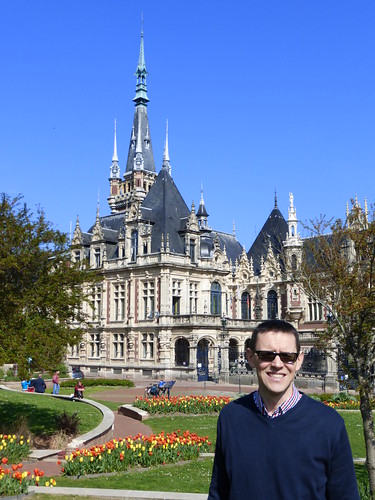 Fécamp is also known for its Palais Bénédictine where the Bénédictine liqueur is made. The building, designed by Camille Albert in the late 19th century is a mixture of neo-Gothic and neo-Renaissance styles. Inside is a museum that displays a large collection of objets d’art as well as rooms adorned in chestnut and oak.
Fécamp is also known for its Palais Bénédictine where the Bénédictine liqueur is made. The building, designed by Camille Albert in the late 19th century is a mixture of neo-Gothic and neo-Renaissance styles. Inside is a museum that displays a large collection of objets d’art as well as rooms adorned in chestnut and oak. 
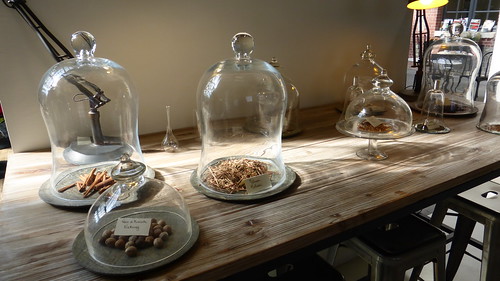
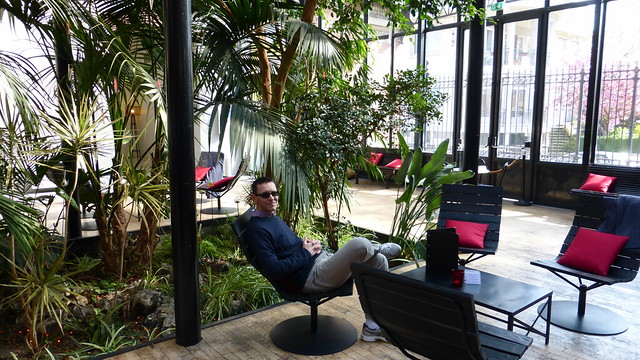 The most interesting parts of the building are the displays of objects and documents relating to the history of making Bénédictine liqueur as well as the visitor’s center with guided tours that show how the liqueur is made. After visiting the souvenir shop, we decided to take a hike along the sailors’ footpath (la sente aux matelots) to the top of the hill called Cote de la Vierge and leads to a park known as Cap Fagnet which overlooks the town.
The most interesting parts of the building are the displays of objects and documents relating to the history of making Bénédictine liqueur as well as the visitor’s center with guided tours that show how the liqueur is made. After visiting the souvenir shop, we decided to take a hike along the sailors’ footpath (la sente aux matelots) to the top of the hill called Cote de la Vierge and leads to a park known as Cap Fagnet which overlooks the town. 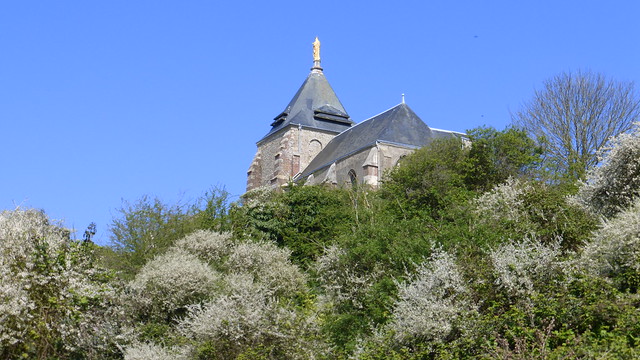
 At the end of the hike one is greeted by the Chapelle Notre-Dame-de-Salut crowned with a golden statue of the Virgin who looks out over the sea. It was originally built in the eleventh century as a chapel where pilgrims from northern France could come to honor the “Precious Blood of Christ.”
At the end of the hike one is greeted by the Chapelle Notre-Dame-de-Salut crowned with a golden statue of the Virgin who looks out over the sea. It was originally built in the eleventh century as a chapel where pilgrims from northern France could come to honor the “Precious Blood of Christ.” 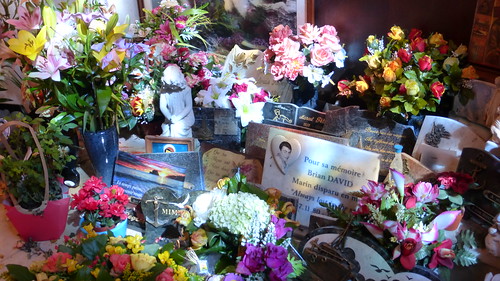 It escaped destruction during the Revolution and found another religious vocation in the nineteenth century when the fishermen of Fécamp made the chapel the goal of their pilgrimages before leaving on trips to Newfoundland via the same path I climbed known as la sente aux matelots.
It escaped destruction during the Revolution and found another religious vocation in the nineteenth century when the fishermen of Fécamp made the chapel the goal of their pilgrimages before leaving on trips to Newfoundland via the same path I climbed known as la sente aux matelots. 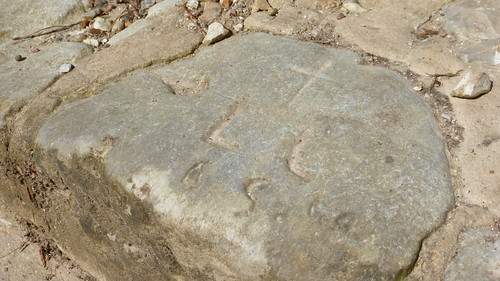 Some of the steps leading up to the chapel are adorned with religious images carved by sailors many years ago. Inside is a memorial with candles, ex-votos and flowers to all those lost at sea.
Some of the steps leading up to the chapel are adorned with religious images carved by sailors many years ago. Inside is a memorial with candles, ex-votos and flowers to all those lost at sea. 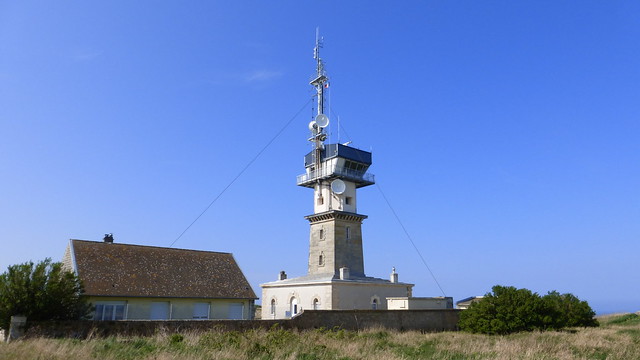 Another fixture atop the hill is the Sémaphore built in 1808 to help boats navigate to shore.
Another fixture atop the hill is the Sémaphore built in 1808 to help boats navigate to shore. 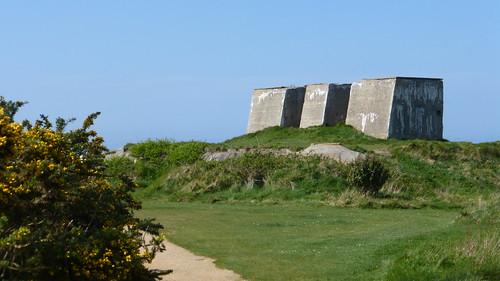
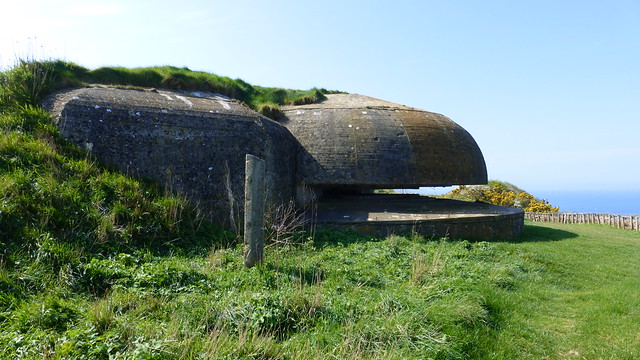
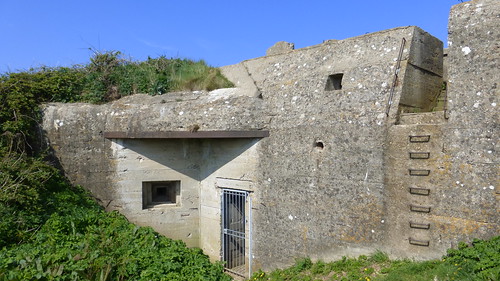 During World War II, the Germans built several large bunkers and gun turrets along the alabaster coastline which can still be seen.
During World War II, the Germans built several large bunkers and gun turrets along the alabaster coastline which can still be seen. 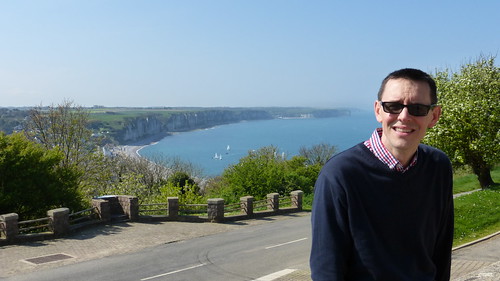
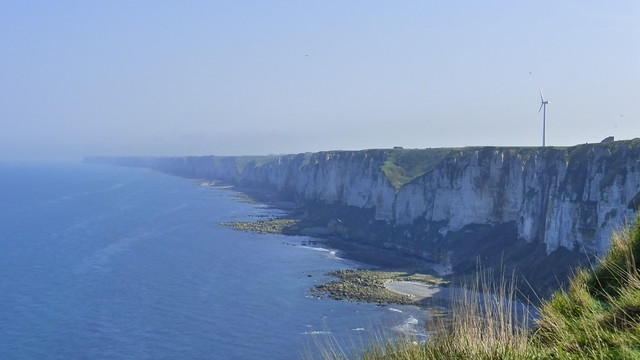 These white cliffs stretch as far as the eye can see to Étretat on one side and Dieppe on the other.
These white cliffs stretch as far as the eye can see to Étretat on one side and Dieppe on the other. 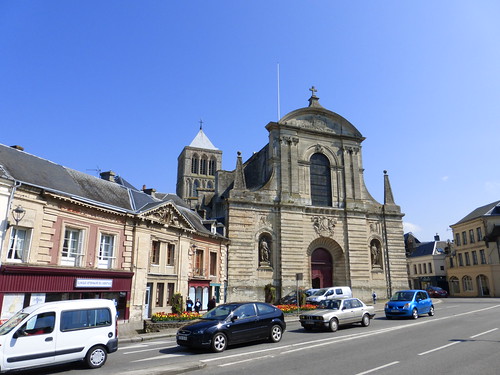
 In the city down below are many old houses as well as churches that conjure up Fécamp’s medieval history including the Abbaye de la Trinité founded in 658. The cathedral is one of the longest in France at 127 meters, equal to that of Notre-Dame in Paris. The façade of the abbey features the statues of Richard I and Richard II.
In the city down below are many old houses as well as churches that conjure up Fécamp’s medieval history including the Abbaye de la Trinité founded in 658. The cathedral is one of the longest in France at 127 meters, equal to that of Notre-Dame in Paris. The façade of the abbey features the statues of Richard I and Richard II. 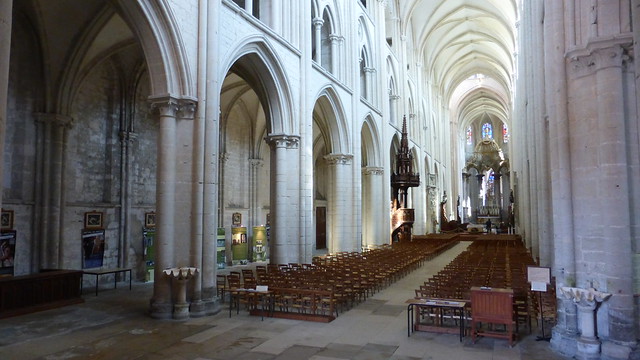
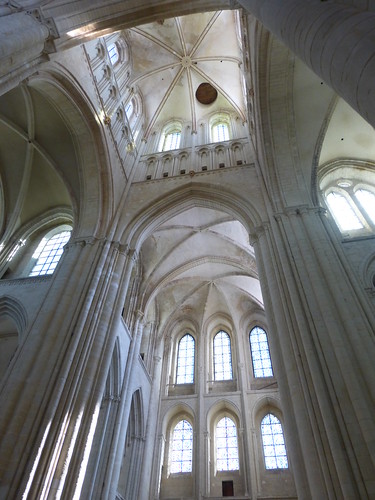 Above the transept crossing rises the square lantern tower designed in the typical Norman style.
Above the transept crossing rises the square lantern tower designed in the typical Norman style. 
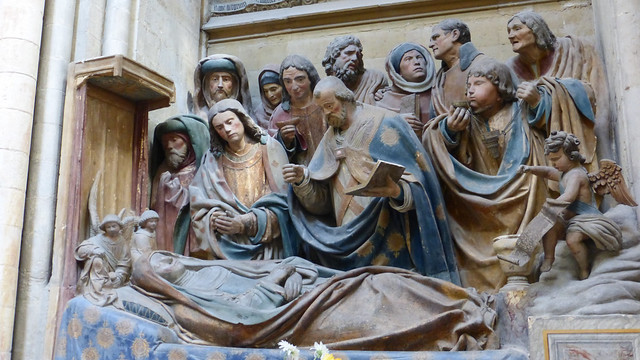
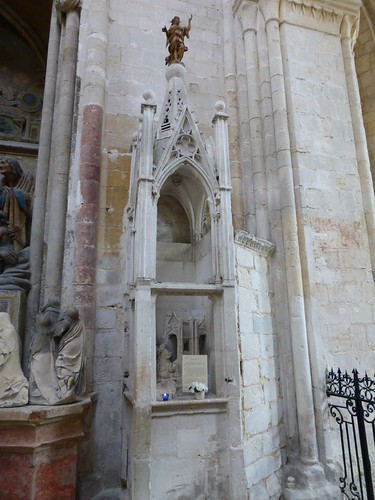 Inside the south transept is a beautiful 15th century sculpture known as the Dormition of the Virgin. To the right is the Angel’s Footprint. In 943, when the reconstructed church was being consecrated, it is said that an angel appeared and left his footprint on the stone.
Inside the south transept is a beautiful 15th century sculpture known as the Dormition of the Virgin. To the right is the Angel’s Footprint. In 943, when the reconstructed church was being consecrated, it is said that an angel appeared and left his footprint on the stone. 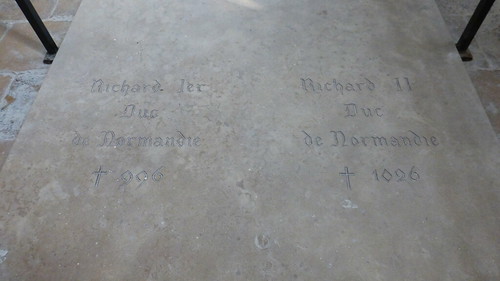
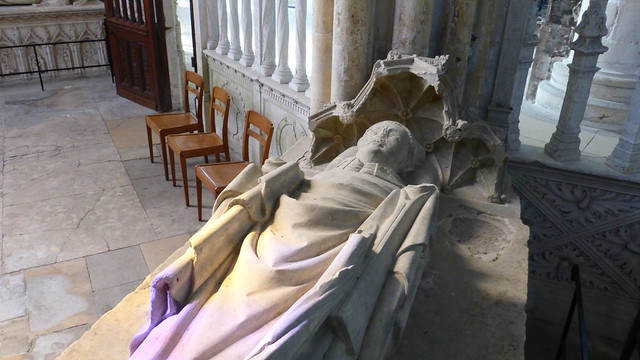 There are several recumbent effigies and tombs within the church as well including those of the two benefactors of the abbey, Richard I (943 – 996), grandson of Rollon, a Viking chief and beside him, his son Richard II (996 – 1026).
There are several recumbent effigies and tombs within the church as well including those of the two benefactors of the abbey, Richard I (943 – 996), grandson of Rollon, a Viking chief and beside him, his son Richard II (996 – 1026). 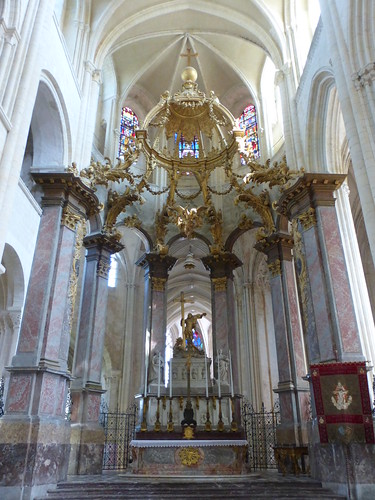 The high altar was rebuilt in the mid-eighteenth century with a lavish canopy of gilded wood and pillars of red marble.
The high altar was rebuilt in the mid-eighteenth century with a lavish canopy of gilded wood and pillars of red marble. 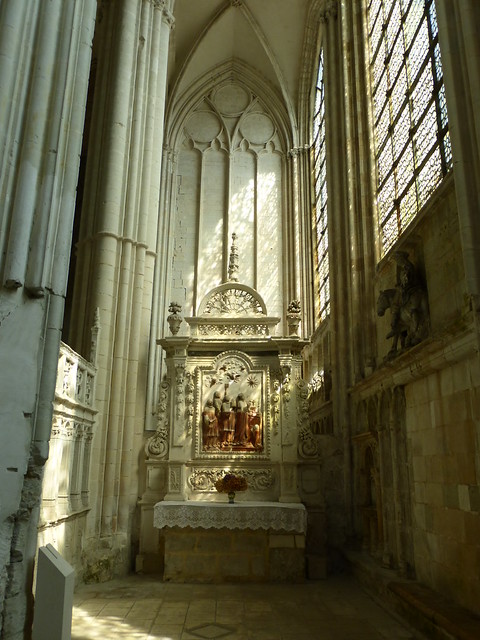

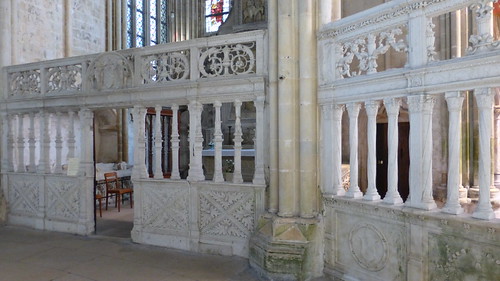 The side chapels around the church are all enclosed with stone walls which are intricately decorated and altars that are ornately carved. One interesting feature of the church is the astronomical and tidal clock which dates from 1667 and is still in good working order.
The side chapels around the church are all enclosed with stone walls which are intricately decorated and altars that are ornately carved. One interesting feature of the church is the astronomical and tidal clock which dates from 1667 and is still in good working order.  It is one of the first clocks of its kind to display two needles to indicate the hours and minutes as well as the phases of the moon and tidal forces of Fécamp.
It is one of the first clocks of its kind to display two needles to indicate the hours and minutes as well as the phases of the moon and tidal forces of Fécamp.  Behind the high altar facing the chapel to Our Lady is the tabernacle containing the relic of the Precious Blood of Jesus.
Behind the high altar facing the chapel to Our Lady is the tabernacle containing the relic of the Precious Blood of Jesus. 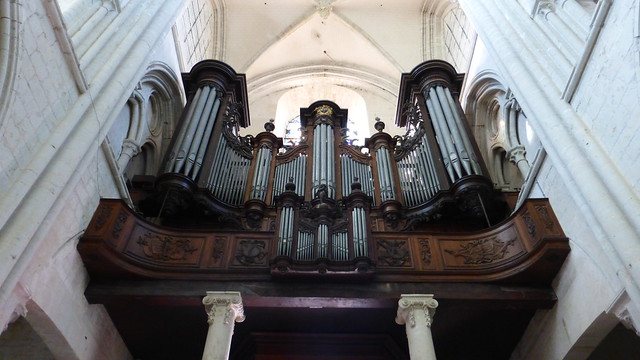 The fine organ above the western portal was installed in 1746.
The fine organ above the western portal was installed in 1746.  Across from the abbey is the home of the monks from the seventeenth century, known as Maison des Moines insoumis.
Across from the abbey is the home of the monks from the seventeenth century, known as Maison des Moines insoumis. 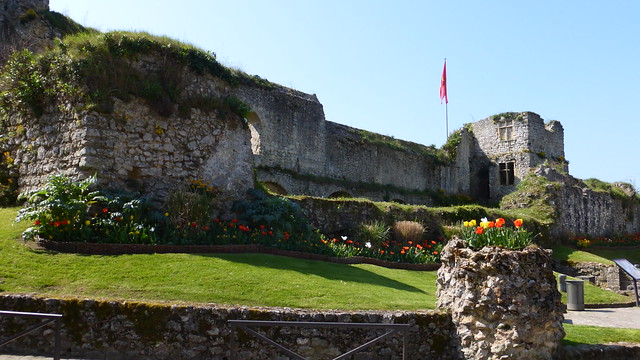 Another interesting residence is the Ducal Palace which was originally built in the 10th century on the site of an ancient nunnery destroyed by the Vikings. At the end of the 12 century, Henri II Plantagenet, the husband of Eleanor of Aquitaine, came to Fécamp to assert his rights over Normandy. He built the enormous fortified bastion on top of the ancient ramparts which can still be seen today. It was eventually dismantled and the castle was integrated into the monastic property around the abbey.
Another interesting residence is the Ducal Palace which was originally built in the 10th century on the site of an ancient nunnery destroyed by the Vikings. At the end of the 12 century, Henri II Plantagenet, the husband of Eleanor of Aquitaine, came to Fécamp to assert his rights over Normandy. He built the enormous fortified bastion on top of the ancient ramparts which can still be seen today. It was eventually dismantled and the castle was integrated into the monastic property around the abbey.  This is a long section of wall known as the Dukes’ Wall which is a vestige of the defensive wall of the palace and the Abbey erected in the 11th century.
This is a long section of wall known as the Dukes’ Wall which is a vestige of the defensive wall of the palace and the Abbey erected in the 11th century. 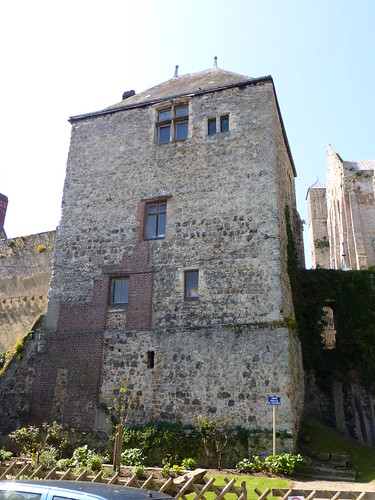 This is La tour de la Maîtrise or Choir School Tower. It is part of the ancient exterior fortifications whose defences were composed of alternating round and square towers. It rises to two floors and in the Middle Ages it housed the famous Fécamp music school that provided the abbey with instrumental and vocal music. It is said that the choir’s repertoire was so extensive that it could be sung for ten years without ever repeating the same piece twice.
This is La tour de la Maîtrise or Choir School Tower. It is part of the ancient exterior fortifications whose defences were composed of alternating round and square towers. It rises to two floors and in the Middle Ages it housed the famous Fécamp music school that provided the abbey with instrumental and vocal music. It is said that the choir’s repertoire was so extensive that it could be sung for ten years without ever repeating the same piece twice. 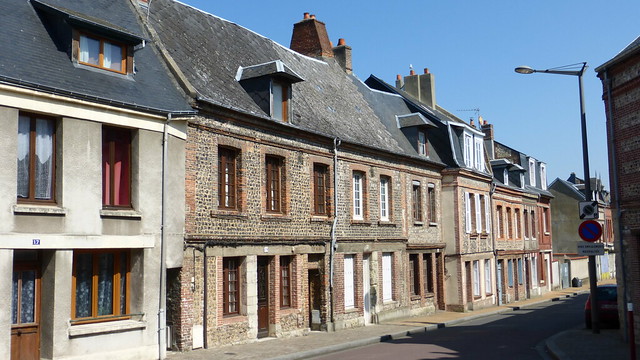 A walk through the old town takes you past many old houses which were originally workshops and homes of artisans and shopkeepers attracted to this area by the continual flow of pilgrims who visited the abbey.
A walk through the old town takes you past many old houses which were originally workshops and homes of artisans and shopkeepers attracted to this area by the continual flow of pilgrims who visited the abbey.  Nearby is the old hospital with a chapel built over a stream. Another very small building in the area is known as the Chapelle du Précieux-Sang and although it is not recognized by the local Catholic Community, in the garden adjoining the chapel is a spring whose waters are supposed to cure eczema.
Nearby is the old hospital with a chapel built over a stream. Another very small building in the area is known as the Chapelle du Précieux-Sang and although it is not recognized by the local Catholic Community, in the garden adjoining the chapel is a spring whose waters are supposed to cure eczema.  According to some 19th century documents, owners of this garden charged patients for a few ounces of the holy water. One of the nicest surprises that Fécamp had to offer was le petit parc, a small green oasis located amidst all the buildings in the newer part of town.
According to some 19th century documents, owners of this garden charged patients for a few ounces of the holy water. One of the nicest surprises that Fécamp had to offer was le petit parc, a small green oasis located amidst all the buildings in the newer part of town. 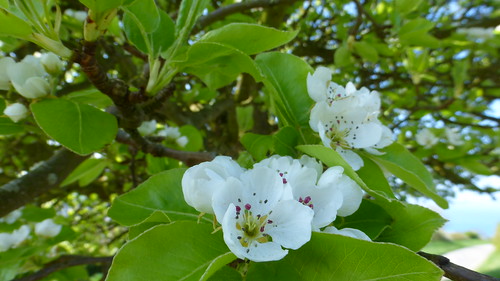

 Inside, is the memorial to fisherman lost at sea erected for the “Thousand Years of Normandy” celebrations in 1911. It draws inspiration from the figure heads of Viking ships.
Inside, is the memorial to fisherman lost at sea erected for the “Thousand Years of Normandy” celebrations in 1911. It draws inspiration from the figure heads of Viking ships. 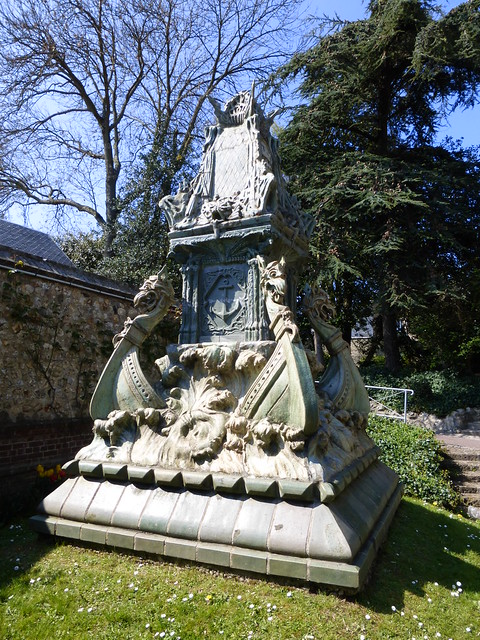
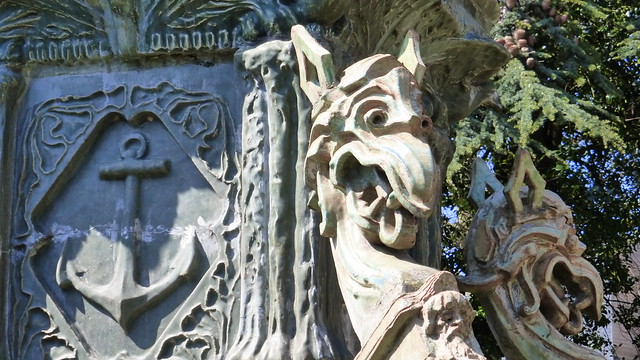 In all, Fécamp was a great place to spend the morning.
In all, Fécamp was a great place to spend the morning.



